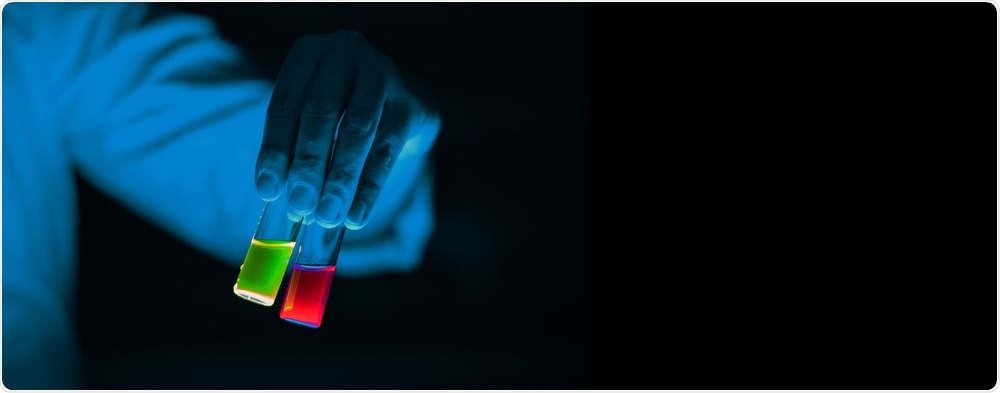The severe acute respiratory syndrome coronavirus 2 (SARS-CoV-2) genome encodes for four structural proteins, of which include the nucleocapsid (N), spike (S), membrane (M), and envelope proteins. The S protein is essential for the pathogenicity of SARS-CoV-2, as the receptor-binding domain (RBD) of the S1 subunit of this protein binds to the angiotensin-converting enzyme 2 (ACE2) receptor on the host cell to allow for viral entry. Comparatively, the N-terminal domain of the S2 subunit is required for membrane fusion.
For long-term drug development purposes, assays targeting just these few sites will likely be insufficient. Many complicated viruses, such as the human immunodeficiency virus (HIV) and Hepatitis C virus, can quickly adapt to new drugs; therefore, a combination of drugs is required to effectively combat them. In a recent study published on the preprint server bioRxiv*, researchers discuss their development of a new high-throughput assay that targets a well-conserved macrodomain within a non-structural protein, thus allowing for rapid screening of potential inhibitors.
 Study: High-throughput Activity Assay for Screening Inhibitors of the SARS-CoV-2 Mac1 Macrodomain. Image Credit: souvikonline200521 / Shutterstock.com
Study: High-throughput Activity Assay for Screening Inhibitors of the SARS-CoV-2 Mac1 Macrodomain. Image Credit: souvikonline200521 / Shutterstock.com
Background
Mac1 is a highly conserved macrodomain adenosine diphosphate (ADP) ribosylhydrolase within nonstructural protein 3 (nsp3). A macrodomain is a protein fold seen in humans, as well as many pathogens. Nearly all macrodomains bind to ADP-ribose.
SARS-CoV-2, as well as two other human coronaviruses like SARS-CoV and the Middle East respiratory syndrome coronavirus (MERS-CoV), contain two or three macrodomains in which the first (Mac1) can bind to ADP-ribosylhydrolase. Similar domains are also seen in alphaviruses, which is another group of viruses that scientists have warned is at risk of potentially giving rise to a pandemic.
When these macrodomains are mutated, viral replication is inhibited and virulence decreased. The ability to fight multiple diseases, as well as inhibit pathogenesis, makes Mac1 an excellent drug target.
About the study
Initially, the researchers attempted to discover whether it was possible to inhibit the viral Mac1 domain without also inhibiting the very similar human MacroD2 domain. Both of these domains are classified as MacroD-type domains.
The Chikungunya virus has a similar macrodomain that can hydrolyze ADP-ribose from PARP10 catalytic domain and G3BP1 protein from cells. Testing confirmed that both the human and SARS-CoV-2 domains could replicate this ability, solidifying them as active ADP-ribosylhydrolases.
The researchers then developed a luminescence-based assay to measure the enzymatic activity. When ADP-ribose is released from the protein substrate by the macrodomain, the phosphodiesterase NudF cleaves the ADP-ribose, which leads to the production of phosphoribose and AMP.
As luminescence will only be seen when ADP-ribose is free, the luminescence signal can be controlled by the rate of the macrodomain enzymatic activity. Using this method, the scientists identified different bonding and kinetic properties for both the human MacroD2 domain and the SARS-CoV-2 Mac1 domain, allowing for selective inhibitors of the Mac1 domain to be investigated.
Study findings
The researchers compared the structures of the two domains to discover that roughly 60% of residues at the binding sites are conserved. Following closer examination, distinct surfaces in the active site that binds ADP-ribose showed key differences, such as the Mac1 is larger and possesses more charged surfaces than MacroD2.
Following this, the researchers identified 3,233 potential candidates for selective Mac1 inhibitors, which were then used for a pilot screen. In total, 37 of these compounds were found to exhibit reproducible inhibition of Mac1 at a concentration of 100 micromolar (uM).
The authors have created an assay that can successfully identify ADP-ribosyhydrolase inhibitors and easily distinguish between those that can inhibit the target selectively and those that are more general. While many of the compounds identified showed cytotoxicity at the concentrations used, the researchers have confirmed this assay’s proof of concept.
Although the current pandemic is slowly being brought under control through the use of mass-vaccination programs, as well as continuing social distancing and lockdown restrictions, coronaviruses are sure to remain a threat for years to come. The assay discussed here could therefore prove to be a powerful tool in helping to develop drugs, against coronaviruses, as well as alphaviruses. Furthermore, the researchers are hopeful that this assay could also be used to develop some broad-spectrum antivirals, which is a currently neglected area of research that has recently seen some large investments.
*Important notice
bioRxiv publishes preliminary scientific reports that are not peer-reviewed and, therefore, should not be regarded as conclusive, guide clinical practice/health-related behavior, or treated as established information
- Dasovich, M., Zhuo, J., Goodman, J. A., et al. (2021) High-throughput Activity Assay for Screening Inhibitors of the SARS-CoV-2 Mac1 Macrodomain. bioRxiv. doi:10.1101/2021.10.07.463234. https://www.biorxiv.org/content/10.1101/2021.10.07.463234v2.
Posted in: Device / Technology News | Medical Science News | Medical Research News | Disease/Infection News
Tags: ACE2, Adenosine, Angiotensin, Angiotensin-Converting Enzyme 2, Assay, Cell, Chikungunya, Coronavirus, Coronavirus Disease COVID-19, Cytotoxicity, Drugs, Enzyme, Genome, Hepatitis, Hepatitis C, HIV, Immunodeficiency, Membrane, MERS-CoV, Pandemic, Protein, Receptor, Research, Respiratory, SARS, SARS-CoV-2, Severe Acute Respiratory, Severe Acute Respiratory Syndrome, Structural Protein, Syndrome, Virus

Written by
Sam Hancock
Sam completed his MSci in Genetics at the University of Nottingham in 2019, fuelled initially by an interest in genetic ageing. As part of his degree, he also investigated the role of rnh genes in originless replication in archaea.
Source: Read Full Article
